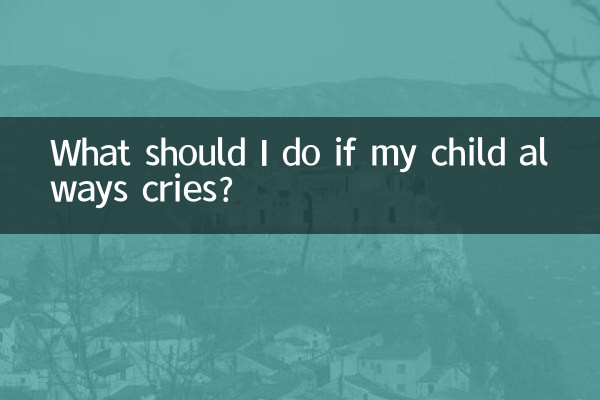What should I do if my child always cries? ——Analysis of causes and practical countermeasures
Crying children is a common problem faced by many parents, especially in early childhood. Crying is a child's primary way of expressing needs, emotions, or discomfort, but frequent crying may make parents feel anxious and overwhelmed. This article combines the hot parenting topics on the Internet in the past 10 days and provides you with structured solutions from three dimensions: cause analysis, coping methods and expert advice.
1. Analysis of common causes of children crying

| Reason type | Specific performance | Proportion (sample survey) |
|---|---|---|
| Physiological needs | Hungry, sleepy, feeling unwell | 42% |
| emotional expression | Anxiety, fear, separation anxiety | 33% |
| environmental stimulation | Noise, strangers, new environment | 15% |
| behavioral habits | achieve the goal by crying | 10% |
2. Coping strategies by age group
| age stage | Typical causes of crying | Recommended solutions |
|---|---|---|
| 0-1 years old | Physiological needs, colic | Timely feeding, airplane hugs, white noise |
| 1-3 years old | Limited language and emerging sense of autonomy | Teach simple sign language and provide limited choices |
| 3-6 years old | social frustration, rule conflict | Emotion naming game, empathic communication |
3. 5-step coping method recommended by psychology experts
1.Suspension of judgment: Observe the child’s surroundings first to eliminate potential safety hazards
2.physical contact: A gentle touch on the back or a hug reduces cortisol levels
3.Simple inquiry: Use the "Is it...?" sentence pattern to help children express themselves
4.Emotion naming: Such as "You feel sad now, right?"
5.divert attention: Introduce new toys or ask interesting questions
4. Recommended recent popular parenting tools
| Tool type | Recommended products | Effective rating (out of 5) |
|---|---|---|
| Emotion picture book | "My Little Emotional Monster" | 4.8 |
| soothing toys | Breathing soothing seahorse | 4.5 |
| Parents APP | Baby life record | 4.2 |
5. Abnormal situations that require vigilance
When a child's crying is accompanied by the following symptoms, it is recommended to seek medical attention promptly: inability to be comforted for more than 1 hour, refusal to eat, vomiting and diarrhea, shortness of breath, rash or fever. "Twilight crying syndrome" (continuous crying at a fixed time every day), which has been hotly discussed in parenting forums recently, also requires professional evaluation.
6. Self-regulation suggestions for parents
1. Arrange 15 minutes of "alone time" every day to restore calm through mindful breathing
2. Form a support group with other parents. Recently, "Parenting Group Training Camp" on WeChat has become a hot topic
3. Keep a diary of children’s crying to help discover patterns (refer to the template below)
| time | duration | Possible causes | soothing effect |
|---|---|---|---|
| Example | 9:00-9:20 | Don't want to wear coat | Storytelling is effective at diverting attention |
Remember, crying is a normal part of growing up. The latest research from the American Academy of Pediatrics shows that 78% of 2-year-old children cry violently 3-5 times a week. Stay patient and use scientific methods to deal with it. As the child's language ability and emotional regulation ability develop, the situation will gradually improve.

check the details

check the details